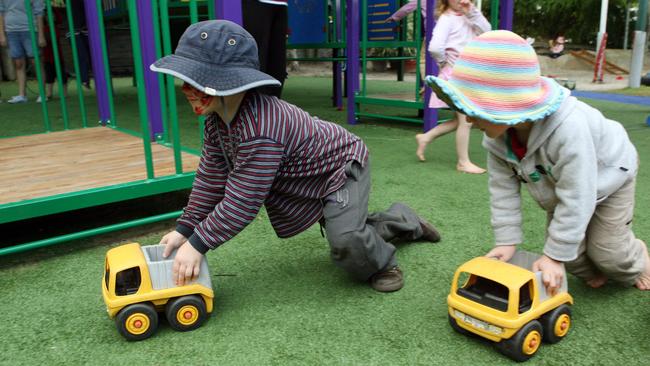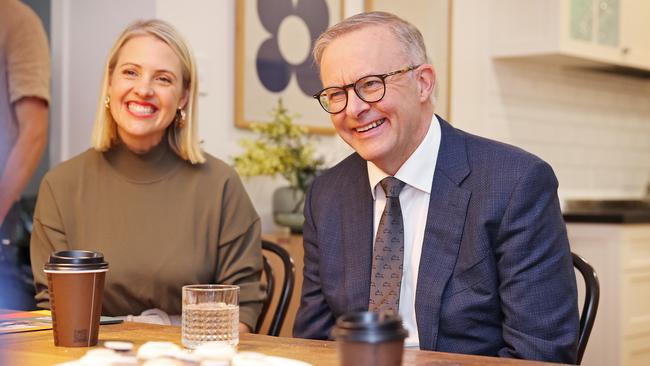Paid parental leave and childcare subsidy changes: What they mean for you
Relief is on the way for Aussie parents with changes planned to childcare fees and paid parental leave. See how they affect you.

National
Don't miss out on the headlines from National. Followed categories will be added to My News.
Huge relief is on the way for families struggling with the cost of childcare with a new draft law set to make childcare fee for low-income families.
Under the proposal up for consultation, three days per week of early learning would be guaranteed for all children aged five and under, capped at $10 per day, and free for low-income families.
And in another win for Aussie families, parents would receive up to 52 weeks of paid parental leave if the bill gets the green light. That’s after the scheme was expanded to 26 weeks on Monday.
Here is what you need to know.
HOW MUCH IS CHILDCARE IN AUSTRALIA?
Services Australia, formerly the Department of Human Services, currently offers a Child Care Subsidy rate of 90 per cent, which families can apply for to access assistance in paying for early childhood education.
However, according to Care for Kids, if a family is ineligible for the government’s subsidy, it can cost up to $200 a day for one child in a centre.

WHAT IS THE CURRENT PAID PARENTAL LEAVE?
Australia’s paid parental leave scheme was expanded to 26 weeks after the government’s first tranche of reforms passed through the Senate on Monday.
Under the changes, the 20 weeks of paid leave parents can access will be gradually increased by two weeks each year from July 2024 until the 26 week rate is reached in 2026.
The rate of pay, which is equivalent to the national minimum wage – about $882.75 per week – has remained the same.
Starting July 1, new parents who either had or adopted a child after July 2023 can access the expanded maternity leave scheme.
The full 20 weeks, which will first increase to 22 weeks this year, is provided to both parents if their combined income is less than $350,000.
If a couple’s combined income exceeds that amount, the majority of the leave can be provided to one parent who earns less than $168,865.
A single parent must be earning less than $350,000 to access maternity leave payments.
The change is set to help more than 180,000 families each year at a taxpayer cost of $4.4 billion, annually, from 2026/27.
WHY IS THERE A NEW DRAFT LAW?
According to recent data from the Productivity Commission, out-of-pocket child care costs have risen substantially for families living in every state and territory in Australia.
Victorians currently pay the highest daycare bill in the country, with the average cost of 50 hours of centre-based care at $626 a week.
The government increased its childcare subsidy for families earning under $530,000 last July, however, according to a report from the Australian Competition and Consumer Commission, fees rose by nearly double the rate of wages and inflation between 2018 to 2022.
Thrive by Five’s Jay Weatherill said too many Australian children were not able to attend childcare and preschool because their parents cannot afford it.
“Many families say the cost of early learning is akin to that of a second mortgage. Others are turned away from their local childcare centre or preschool because the waitlist is astronomically long,” he said.
“We would never stand for that happening with primary or secondary education – early years education should be no different.”
WHAT IS BEING PROPOSED?
Parenthood CEO Georgie Dent said the recent announcement to include superannuation in paid parental leave next year and expand entitlements to 26 weeks by July 2026 marked “good progress”.
But she said there was still a long way to go to reduce financial hurdles for Australian parents.
“We hear time and time again from parents – particularly from those living regionally and remotely, or those from lower-income households – that it either didn’t make sense financially to progress their careers once they had children or that it was simply impossible due to care being inaccessible,” Ms Dent said.
“Whether it’s the high cost, the years-long waitlist, or the fact that there are simply no services in their area – too many parents and children miss out.”
The policy is in line with recommendations from the government’s Women Equality Taskforce, which called to immediately establish universal childcare and extend the paid parental leave scheme to 52 weeks to ensure women aren’t burdened financially after having children.

WHY IS IT IMPORTANT?
Ms Weatherill says this draft bill would enshrine a necessary national framework to ensure that positive reforms can’t be undone when governments inevitably change.
The draft bill proposes the creation of a national Early Childhood Development Commission to work with federal, state and territory governments to implement the reforms over 10 years.
A $10-a-day model has successfully been implemented in other parts of the world, including Quebec in Canada.
More Coverage
Originally published as Paid parental leave and childcare subsidy changes: What they mean for you





